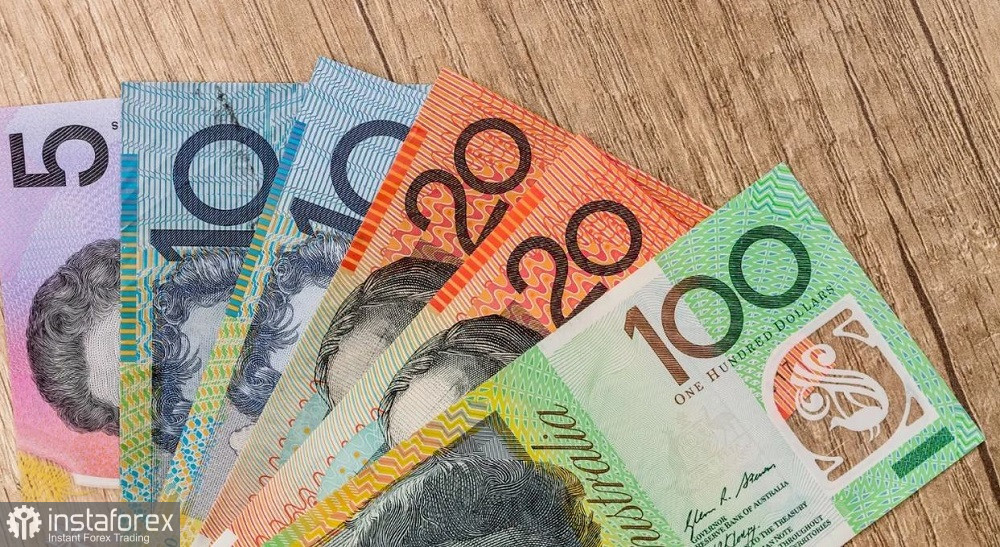The AUD/USD pair once again tested the support level at 0.6290, which corresponds to the lower Bollinger Bands indicator line on the daily time frame. The bears have been challenging this price barrier for three consecutive weeks, starting from early October. On Monday, they tried to consolidate below the 0.62 level, but ultimately failed. Following this, the bulls took the initiative and in just a day, the aussie strengthened by nearly 100 pips. Not only was this driven by the US dollar's broad weakness but also by the Australian dollar's strength. Hawkish statements from Reserve Bank of Australia Governor Michelle Bullock bolstered the bulls' positions, allowing them to launch a counterattack. However, it is not advisable to rush into long positions right now, as the fundamental picture could change dramatically in the very near future.

The Australian dollar is holding its ground due to several factors. Among them is the "Chinese factor." Economic reports from China, which have been disappointing since the beginning of the year, recently turned out better than consensus estimates. For instance, retail sales rose 5.5% in September, accelerating from a 4.6% increase in August. Industrial output in September grew a stronger than expected 4.5% from a year earlier, while expectations were a 4.3% rise (this indicator has been in the "green zone" for the second consecutive month). Although China's economic growth rate slowed down in the third quarter (4.9% compared to 6.3% in the second quarter), the rise was better than the 4.4% rate forecast by most analysts. China is Australia's largest trading partner, so these relatively good results provided support to the aussie.
However, the main driver of AUD/USD growth is the RBA, which maintains a hawkish stance and does not rule out the possibility of further tightening of monetary policy. Despite announcing a pause in raising interest rates, the central bank regularly states that it is prepared to take action if inflation slows down at an even slower pace or, even more so, if it starts to accelerate. This idea has been articulated multiple times by Phillip Lowe, confirming these intentions with actions when the RBA raised interest rates again after a pause. Now, this idea is reiterated by Phillip Lowe's successor, Michelle Bullock.
Speaking at a global markets conference, Bullock said that the RBA's board "will not hesitate' to increase rates if inflation takes longer than expected to return to target". She noted that the central bank "will not hesitate to raise the cash rate further if there is a material upward revision to the outlook for inflation." Importantly, Bullock made a significant remark that by the next meeting on November 29, the RBA's board will have additional information that will allow them to make an appropriate decision.
This pertains to the inflation data for the third quarter, which is a key report for the RBA. The main report will be released on Wednesday. In addition to that, the Consumer Price Index for September will also be released on the same day. However, the main focus will be on the quarterly data. The aussie's fate in the medium term will depend largely on these numbers. If the data exceeds expert expectations, the question of a rate hike at the November meeting will remain on the agenda. But if the reports meet the forecasted level (let alone fall below it), the Australian dollar will come under significant pressure.
According to the forecasts of most experts, the Consumer Price Index in the third quarter is expected to decrease to 5.3% on an annual basis. After reaching its peak in the fourth quarter of 2022 (7.8%), the index has been consistently declining (7.0% in the first quarter of 2023 and 6.0% in the second quarter of 2023). The third quarter should confirm this trend. In quarterly terms, the index also shows a downtrend: in the fourth quarter of 2022, it increased by 1.9%, in the first quarter of this year by 1.4%, and in the second quarter by 0.8%. According to forecasts, in the third quarter, the index is expected to rise slightly to 1.1%. The core inflation index, as reported by the central bank (using the Trimmed mean method), is expected to decrease to 5.0% in the third quarter (down from the previous value of 5.5%). As for the September CPI figure, a slight increase is expected to 5.3% (in August, it increased to 5.2%). On one hand, the possibilities of growth are minimal, but this could indicate the formation of an uptrend.
It's also worth highlighting the main points from the minutes of the RBA's October meeting. The recently published document had a somewhat hawkish tone. The central bank stated that further monetary policy tightening may be required "if inflation turns out to be more persistent than expected." At the same time, RBA officials acknowledged that progress in reducing inflation had slowed, and the RBA board has "low tolerance for inflation returning to target at a slower pace."
As such, we can not undermine the significance of the inflation report, which will be published on October 25. Strong inflation growth could allow the bulls to test the nearest resistance level at 0.6400 (the Kijun-sen line on the daily chart) with a subsequent target of 0.6450 (the lower edge of the Kumo cloud, coinciding with the upper Bollinger Bands line on the same timeframe). However, if inflation slows down more than expected, the bears may once again return to the "price citadel" of 0.6290, which is the lower Bollinger Bands line on the daily chart.





















